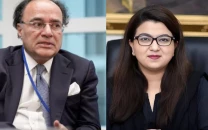Mastermind behind Pearl's murder is an international terrorist: SC informed
Pearl's parents have approached the Supreme Court against the acquittal and release of the four accused
The counsel for slain American journalist Daniel Pearl's parents informed the Supreme Court (SC) on Wednesday that the mastermind behind the murder is an international terrorist.
Pearl, the then South Asia bureau chief for The Wall Street Journal was abducted in Karachi in January 2002 while researching for links between militants in Pakistan and Richard C Reid. A graphic video showing Pearl’s decapitation was delivered to the US consulate in Karachi nearly a month after he was kidnapped.
"The crimes which are the subject matter of these present petitions have to be understood within the context of the fact that the mastermind of these crimes, Ahmed Omar Sheikh, was an international terrorist, especially involved in other kidnappings for ransom incidents. These facts find support both from a judgment of the Indian Supreme Court, as well as the defence's own evidence. Therefore, this context of international terrorism is crucial in adjudicating these present petitions," the written submission - filed by counsel Faisal Siddiqui - said.
Pearl's parents, Ruth Pearl and Judie Pearl have approached the Supreme Court against the acquittal and release of the four accused.
The Sindh High Court (SHC) had commuted the death sentence of Sheikh - the man convicted of kidnapping and murdering the American journalist in 2020 - to a seven-year sentence.
Meanwhile, the SHC had also acquitted three others who had been awarded life imprisonment in the case. The order came almost two decades after they were found guilty and subsequently jailed.
Siddiqui maintained that the case could be divided into three broad categories and in three time periods; pre-abduction for ransom period, abduction for ransom period and murder period.
"Three substantive offences ie. conspiracy, abduction for ransom and murder. Each of these offences are independent as well as inter-dependent of each other and have to be proved in themselves. Each offence has to be proved independently and the evidence in relation to each of the offence differs both in strength and in volume and as a consequence, the occurrence and proof of each of these offences is to be decided separately," the counsel noted.
He further added that there are three sets of accused ie. Ahmed Omar Sheikh, Fahad Naseem, Salman Saqib and Sheikh Adil. The guilt of each set of accused has to be proved independently and the evidence against each set of accused differ both in strength and in volume and, as a consequence, there guilt and sentence is to be decided separately.
The counsel went on to say that the evidence relied upon in these petitions is not simple circumstantial evidence, but is based on direct evidence - particularly judicial confessions. "The evidence relied upon is oral, documentary, forensic and judicial confessions."
Furthermore, Siddiqui underscored that the SHC verdict be set aside because it is based on a gross misreading of the evidence, disregarding of critical evidence and facts, and a misinterpretation of the law, resulting in findings which are artificial and shocking.
"Moreover, the double presumption of acquittal would not apply in relation to the impugned judgment because, firstly, the two courts below have reached different conclusions, namely, the learned Anti-Terrorism Court has convicted the accused persons for the offences and the honourable Sindh High Court through the impugned judgment has acquitted the accused persons except for the offence of abduction. Secondly, even in the Impugned Judgment, the main accused Omar Sheikh has been convicted at least of the offence of abduction."
The counsel contended that the central flaw of the judgment of the SHC is that it is based on the fundamental premise that the death of Pearl has not been proved as his body has not been recovered. As a consequence, the entire evidence regarding the identity of Pearl and actions in relation to the abduction for ransom and murder is thrown in doubt.
The counsel will continue his arguments at the hearing on December 17.


















COMMENTS
Comments are moderated and generally will be posted if they are on-topic and not abusive.
For more information, please see our Comments FAQ